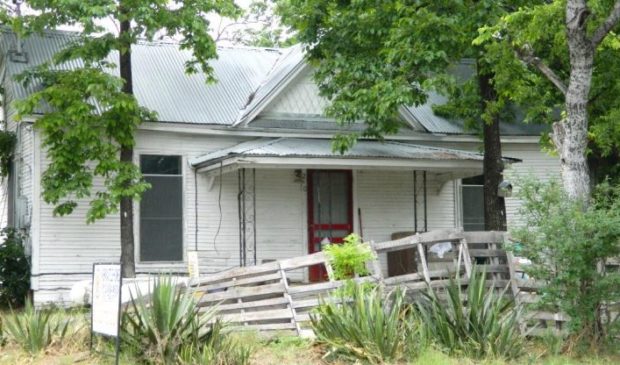New plan fails to impress in the wake of unapproved East Austin demolition
Monday, July 25, 2016 by
Elizabeth Pagano Almost two years later, one East Austin homeowner is back at the Board of Adjustment asking for a variance redo, with a promise to reconstruct the demolished home it had promised to preserve.
At this point, owner 2100 E. 14 Ventures LLC is seeking a variance for the property at 2100 E. 14th St. to increase the allowed size of a second dwelling unit from 1,100 square feet to 1,356 square feet.
The variance was granted previously, with the condition that historic zoning be applied to the house. That is no longer possible because during construction, the two walls of the original 1906 home that were to be preserved collapsed.
None of the board members indicated support for the variance, and many explicitly said they would not support the new request. But the board postponed it nonetheless, in order to allow the neighborhood some time to work out a plan with the developers. Board members voted 10-1 to postpone the case to their August meeting, with Board Member Michael Benaglio voting in opposition.
Board Member Don Leighton-Burwell offered the neighborhood some advice for the next month.
“I would encourage the neighborhood to push for exactly what you want with this,” he said. “Because I don’t think the applicant, at this point, has a leg to stand on.”
Jamie Crawley spoke on behalf of the homeowner. He explained that the project was now one of reconstruction, not preservation. He indicated that the completed home would still be “exactly historically accurate” and that they intend to pursue historic zoning once the project was complete.
“If you pass by that home, you will see a historic home that has all the historic details – the scale, the character of it – but it will be safe,” said Crawley. “We’re trying to re-create every single detail.”
Crawley noted that the design of the project had not changed and that the main home and secondary home have both received Certificates of Appropriateness from the Historic Landmark Commission.
Board Member Michael Von Ohlen was not persuaded by the new plan, nor by the idea that a new building could be historic.
“You can’t duplicate what was built back in that time with modern-day stuff,” he said. “You can copy it, but you can’t build it.”
Von Ohlen said he was troubled by pictures that showed the two facades, before their collapse, supported by temporary bracing, which demonstrated to him “that they still had some stability.” He also said there was no evidence that the walls were dangerous or termite-infested. Von Ohlen said that, in the past, when those conditions existed, people had returned to the board with pictures prior to demolition. “This case isn’t that way,” he said.
“As soon as those walls became a problem, the inspector should have been called. Because that’s the way it’s done,” said Von Ohlen. “Our previous variance went down when those walls went down.”
Von Ohlen said that four or five times during his tenure on the board, he had seen similar cases in which walls that were supposed to be preserved “mysteriously fell down.” Several neighbors have written letters to the board saying that the walls did not collapse, as claimed by the developers, Newcastle Homes, but were deliberately demolished.
Cavan Merski, who is the chairman of the Chestnut Neighborhood Plan Contact Team, spoke against the variance. He explained that he had taken part in the process that crafted the original agreement two years ago. That agreement, he said, had “very specific stipulations” that were not being honored now. He said that his team had voted to postpone the case in order to speak with the applicant and, if that wasn’t possible, to oppose the variance.
“We asked specifically for those facade walls to remain, and they are not there anymore,” said Merski, who added that those associated with the project didn’t tell anyone they would be demolishing the walls in direct violation of the variance granted in 2014 and the Certificate of Appropriateness.
Board Member Bryan King, who was on the board when the original variance was granted, agreed.
“The trade-off was they kept it, and they didn’t keep it,” said King. “We’re not going to have a historic structure, we’re going to have a copy of a historic structure, and they didn’t abide by what the variance conditions were.”
Neighbor Kathy Taylor pointed out that the original one-story, 110-year-old home was 928 square feet. The new home that is proposed is “just shy of 1,700 square feet” and has two stories. She said that, when the two walls came down, construction continued until the city issued a stop work order, as the project was no longer in compliance with its building permit. Right now, the home stands half-completed.
As part of the case, the applicant also submitted wind and weather data from February and March of this year, and pointed out that the excessive wind and rain was “just too much for the 100 year old facades to take!” However, Merski noted that the wind speeds were “completely average” and the rain events were also normal. “I’m not going to bore you with weather data, but I have it prepared,” he said.
The Austin Monitor’s work is made possible by donations from the community. Though our reporting covers donors from time to time, we are careful to keep business and editorial efforts separate while maintaining transparency. A complete list of donors is available here, and our code of ethics is explained here.
You're a community leader
And we’re honored you look to us for serious, in-depth news. You know a strong community needs local and dedicated watchdog reporting. We’re here for you and that won’t change. Now will you take the powerful next step and support our nonprofit news organization?









